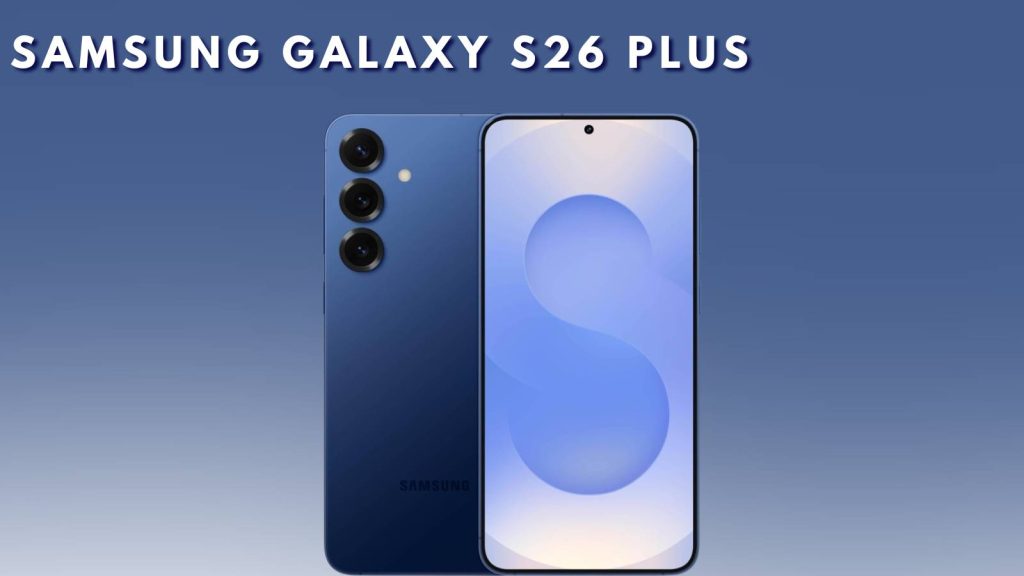Upcoming Samsung Galaxy S26 Plus stands as a key smartphone release for early 2026, bringing together flagship‑level specifications, refined design, and next‑generation technology. Find detail overview—drawing on the latest leaks, official hints and industry analysis—covering everything from launch timing to feature trade‑offs, to help you grasp whether the S26 Plus merits your attention.
Release Date and Pricing: When Will the Galaxy S26 Plus Launch?
Industry sources now indicate the Galaxy S26 Plus is expected to be officially unveiled on 25 February 2026 at Samsung’s Unpacked event. Pre‑orders are likely to open immediately after the announcement, with public availability slated for early March in many markets.
From a pricing standpoint, while no official numbers have yet been disclosed, Samsung’s strategy appears to place the S26 Plus between the standard S26 and the premium S26 Ultra. Given this positioning, users should anticipate a price point that delivers “near flagship” capability without the ultra‑premium alias cost. Importantly, regional variation (currency, taxes, chip supply) may impact final pricing in markets like India.
Additional considerations for buyers:
- Pre‑order and trade‑in promotions may be significant, especially in India and other major markets, offering value that may effectively reduce launch cost.
- Chipset variation by region (Exynos vs Snapdragon) may influence which variant is offered at a specific price tier, potentially affecting resale/trade‑in value.
- Availability timing may differ by region — some markets might receive the device later than others, or in smaller initial quantities.
Design & Build: What’s Changed and What’s Familiar
The design of the Galaxy S26 Plus retains the refined metal‑and‑glass construction typical of Samsung’s flagship S‑series, but several key refinements stand out. Leaked CAD renders indicate a flat frame with slightly rounded edges for improved one‑hand comfort, along with a camera module housed under a discrete platform, rather than a protruding full‑width visor.
Device dimensions are estimated at 158.4 × 75.7 × 7.35 mm, essentially matching its predecessor’s footprint but with refined ergonomics.
Specific enhancements worth noting:
- Rear camera island design is more integrated, reducing visual bulk and likely improving durability (less protrusion means less wobble when placed on a flat surface).
- The build materials may receive an upgrade: though the Plus model may still use an aluminium or frame alloy rather than full titanium, some reports hint at premium finishes and possibly new colour options.
- Button layout and side‑frame finish appear tuned for modern use — the renders show minimal bezel thickness and a centered punch‑hole front camera for symmetry.
What remains similar (or modestly upgraded):
- The overall thickness remains around 7.35 mm — while slim, it isn’t dramatically thinner than previous models, indicating Samsung is balancing battery/camera size with design.
- Glass back remains likely (with wireless charging coil underneath), meaning fingerprint and smudge susceptibility remain levels users are accustomed to.
- While premium, the Plus model may not receive the “top‑tier materials” (e.g., full titanium) reserved for the Ultra variant — so users seeking the ultra‑premium build may still need to look at the Ultra.
Display & Visual Experience
A major upgrade point: the Galaxy S26 Plus is rumoured to feature a 6.7‑inch QHD+ M14 OLED display with a 120 Hz refresh rate. Samsung’s M14 OLED technology reportedly brings improved brightness, better contrast ratios and improved energy efficiency compared with previous generations.
Key facets of the display worth noting:
- QHD resolution across the Plus (not just Ultra) is significant — many prior “Plus” models settled for lower resolution or FHD+, so this move elevates the Plus line.
- The 120 Hz refresh rate offers smoother scrolling, more fluid animations and better responsiveness — benefits especially noticeable in gaming, multitasking and high‑motion content.
- Combination of flat screen (instead of heavy curves), minimal bezels and high brightness makes the display practical for everyday usage (outdoor legibility, one‑hand use, fewer accidental touches).
- Efficiency improvements mean the display may consume less power for the same brightness/refresh conditions vs prior models — contributing to better battery life.
Potential limitations or trade‑offs:
- Although the display spec is exceptional for the Plus model, Samsung may not include some of the very highest display features (e.g., ultra‑high refresh beyond 120 Hz, or extremely advanced LTPO variable refresh) which may still be reserved for Ultra models.
- Some users who value curved‑edge displays for aesthetics may prefer other variants — the flat design is more practical but less “show‑piece”.
- We still await official confirmation of true brightness / HDR performance figures (nits, HDR10+ certification, etc.) — leaks indicate improvements but exact numbers are unconfirmed.
Performance: Chipset, Memory & Storage Upgrades to Watch
Performance is a flagship differentiator, and the Galaxy S26 Plus is expected to deliver meaningful improvements. Leaked specs show that it may be powered by either Samsung’s Exynos 2600 (in select regions) or Qualcomm’s Snapdragon 8 Elite Gen 5 (in markets such as USA/China) — continuing the dual‑chip regional strategy.
Memory & storage options appear generous with baseline suggestions of 12 GB RAM + 256 GB storage, with higher variants likely available (512 GB, possibly 1 TB) depending on market.
What this means in real‑world usage:
- The SoC upgrades should bring faster CPU/GPU performance, better thermal management and improved power efficiency — beneficial for heavy gaming, AR/VR, multitasking and camera‑heavy workflows.
- With 12 GB RAM plus large storage, users can expect smooth performance even with demanding applications (photo/video editing, multi‑window tasks, large internal file storage).
- Regional chipset variation means performance may differ slightly between regions; historically Exynos variants in some Samsung phones have lagged behind Snapdragon counterparts in some benchmarks.
- Future‑proofing: With 12 GB RAM and robust storage, the device is built to support heavy usage and remain relevant for multiple years.
Additional features and user‑impact:
- Firmware leaks suggest the S26 series may include on‑device AI processing, improved camera algorithms and optimized system performance leveraging the chip architecture.
- Storage technology may be UFS 4.0 (or newer) and RAM type likely LPDDR5X — these improvements translate into faster app‑launch times, quicker file transfers, and better responsiveness under load.
Camera System: Photo & Video Upgrades Worth Paying For
Camera upgrades on the Galaxy S26 Plus are among the most substantial rumours to date. Leaks suggest a 50 MP main sensor, a 50 MP ultra‑wide sensor (a substantial upgrade when prior ultra‑wides were much lower resolution), and a 12 MP telephoto sensor with a 1/2.55″ size for the 3× optical zoom.
Moreover, firmware analysis confirms support for Samsung’s Advanced Professional Video (APV) codec, enabling 4K 60fps recording with both front and rear cameras—an important upgrade for creators.
Specific advantages for users:
- Higher‑resolution ultra‑wide means significantly improved detail in landscape and group shots; previously ultra‑wide sensors were weaker links in many phones.
- Larger 12 MP telephoto sensor (with better light capture due to 1/2.55″ size) should offer clearer zoom shots, less noise and better dynamic range compared to prior generation’s smaller sensors.
- Improved low‑light performance across the board thanks to larger sensor sizes and newer optics — for users who shoot in dim environments, this matters.
- Video upgrades including 4K 60, enhanced stabilization, improved autofocus and possibly higher bit‑rate capture make the Plus model more capable for content creation rather than just casual use.
Trade‑offs to note:
- Optical zoom remains at 3×; while the sensor size is improved, competitors may offer higher optical zoom ratios (5×, 10×) in other variants.
- While the ultra‑wide resolution bump is significant, user experience will depend on actual lens optics (autofocus, field‑of‑view distortion, image processing)—not just sensor megapixels.
- Until official sample images and lab‑tests emerge, real‑world performance remains speculative.
Battery, Charging & Connectivity
Battery and charging continue to be major user concerns, and the S26 Plus appears poised to deliver enhancements. The rumoured battery capacity is 4,900 mAh for the Plus model. Wireless charging appears to receive a boost too – reports indicate 25 W wireless charging could be supported, up from prior 15 W norms.
Connectivity features are expected to include: 5G (sub‑6GHz + mmWave depending on region), WiFi 6E or possibly WiFi 7, Bluetooth 5.3 or newer, NFC, and advanced sensor arrays including ultrasonic in‑display fingerprint and improved facial recognition.
User‑experience implications:
- The increased battery capacity plus efficiency gains from the display and chipset should translate into all‑day use even under heavy load (gaming, streaming, navigation) and possibly into a lighter usage second day.
- Faster wireless charging means more convenient top‑ups without cables; improved charging coil design (fewer heat issues) increases longevity and convenience.
- Comprehensive connectivity ensures future‑proofing for network upgrades and accessory compatibility, especially important in regions like India where 5G rollout is accelerating.
- Efficient thermals and smart battery management (leveraging newer silicon) should reduce degradation over time, meaning the device remains “good” over a longer lifespan.
Considerations & caveats:
- Wired charging speeds are still unconfirmed; if Samsung continues to limit wired charging (to preserve battery longevity or margins) some users may prefer higher wattage from competitors.
- As with performance, regional variations (chipset, bands) may mean slightly different battery life or charging behavior depending on country.
- Real‑world battery life depends heavily on software optimisation, network conditions, screen settings, so while capacity is promising, user experience must wait for reviews.
Software & User Experience: One UI and Beyond
Software ecosystem of the Galaxy S26 Plus is likely to be a significant strength. Samsung is expected to ship it with One UI 8 (or the next iteration) based on Android 16 or 17 (depending on regional release timing). Users should expect up to seven years of OS and security updates, continuing Samsung’s longer‑term support strategy.
Key user‑experience features to anticipate:
- AI enhancements: Samsung has teased next‑gen on‑device AI for camera, system optimisation, battery/power management and accessibility features—these should translate to smarter everyday use.
- Ecosystem integration: Deep coupling with Samsung’s broader ecosystem (tablets, wearables, smart home) means a smoother experience for users already invested in Samsung devices.
- Long‑term viability: With seven years support, users buying the S26 Plus today may expect support through 2031–2032, reducing the need to upgrade frequently.
- Customisation and multitasking: One UI’s maturity means features like Flex Mode, multi‑window, performance modes, custom themes and gesture controls should be refined and reliable.
Potential user‑experience trade‑offs:
- Pre‑installed bloatware: As with many Android flagships, removing or disabling certain pre‑loaded apps may be necessary; users should check how Samsung handles “smart” features vs optional ones.
- Update rollout pace: Regional delays may still exist for major OS upgrades or feature drops; sometimes features debut in one region before others.
- UI smoothness depends on hardware + software synergy — even the best specs need real‑world optimisation for thermal, battery stability and longevity.
What’s Not Changing – And What You Might Sacrifice
Understanding what remains unchanged or where trade‑offs are helps in making an informed upgrade decision:
- While the telephoto sensor is significantly improved in size and quality, the optical zoom factor remains at 3× — users needing higher zoom (5×, 10×) may find competitors deliver more in that regard.
- Premium materials and features reserved for Ultra‑tier: For example, S‑Pen support (in Samsung’s ecosystem), largest battery sizes, highest zooms may still be exclusive to the Ultra variant.
- Some rumours suggest the Exynos chipset may be used in many regions for the S26 Plus — historically this has meant slight performance or efficiency differences vs Snapdragon versions. Users in certain markets may want to check the exact variant.
- Charger included/charging speed: There is no definitive confirmation yet, but if Samsung limits wired charging speeds or does not include a high‑wattage charger, that may impact user experience (especially for users switching from faster‑charging phones).
What this means in practice:
- If you prioritise the highest camera zoom, ultra‑premium build materials or S‑Pen stylus features, you may still want to consider the Ultra or alternate brands.
- If you already own the S25 Plus and are satisfied with current performance/camera/battery, the incremental upgrades in S26 Plus may feel modest in your daily usage.
- Region‑specific model variants matter: if you are in a market receiving the Exynos variant, you may want to check benchmarks for that specific version before purchasing.
Galaxy S26 Plus vs. S25 Plus and Rival Flagships
Compared with its predecessor (S25 Plus)
- The S26 Plus is expected to bring a new main camera sensor, larger ultra‑wide lens, improved telephoto sensor and possibly larger battery — upgrades that address previous pain points.
- Display resolution appears upgraded (QHD+ across the board), bringing the Plus model closer to Ultra‑level screen quality.
- Efficiency gains in chipset, display and battery indicate improved real‑world usage (longer battery life, smoother performance) compared to the S25 Plus.
Compared with rival flagship phones (e.g., from Apple, Google, Xiaomi)
- Samsung’s ecosystem and long software‑update promise give it an edge for users seeking longevity and integrated device environments.
- Camera improvements (particularly ultra‑wide and telephoto sensor size) bring the S26 Plus closer to “camera elite” status — narrowing the gap with brands known for zoom or ultra‑wide dominance.
- Price‑to‑feature balance: If Samsung positions the S26 Plus strongly, it could offer near‑flagship performance and build at a lower cost than top‑tier Ultra models from competitors — making it a value flagship.
FAQs
1. What chipset powers the Galaxy S26 Plus?
Samsung uses Snapdragon 8 Elite Gen 5 in some regions and Exynos 2600 in others. The Snapdragon version delivers slightly better GPU performance, while Exynos may differ in power efficiency. Users should check their local variant for optimal performance expectations.
2. Does the S26 Plus support the S‑Pen?
No, the Galaxy S26 Plus does not include S‑Pen support. Only Ultra models or the Note series support stylus input. If you rely on a stylus for note-taking, drawing, or precision tasks, you may need to consider the Ultra variant.
3. How fast is the charging on the S26 Plus?
The phone supports fast wired charging and up to 25 W wireless charging. Samsung may also implement improved wireless coil alignment and efficiency for faster and safer top-ups. Quick-charge times can vary depending on the charger and battery conditions.
4. Can I expand storage with a micro‑SD card?
No, the S26 Plus relies entirely on internal storage options ranging from 256 GB to possibly 1 TB. Users who store high-resolution videos, games, or large apps should select higher storage variants, as micro‑SD expansion is not available.
5. How long will Samsung update the S26 Plus?
Samsung will provide up to seven years of OS and security updates. This ensures long-term device support, meaning users can enjoy the latest Android features and security patches without upgrading the phone frequently.
6. Can the S26 Plus record professional 4K video?
Yes, it supports 4K at 60fps video recording with advanced video stabilization and the APV codec. This makes it suitable for vloggers, content creators, and anyone seeking high-quality video without professional equipment.
7. How long does the battery last?
The 4,900 mAh battery, combined with an efficient chipset and OLED display, delivers all-day battery life under normal usage. Heavy usage like gaming or high-refresh-rate streaming may reduce endurance slightly, but the device still offers competitive battery performance.
8. What changes in the design of the S26 Plus?
Samsung adds a flat frame, minimal bezels, and a cleaner rear camera module. These changes improve handling, reduce accidental touches, and make the phone feel more modern while maintaining premium materials for durability.
9. Are there regional differences in specs?
Yes, chipset, network bands, and accessory bundles may vary by region. Some regions receive Exynos chips, while others get Snapdragon, affecting performance. Buyers should verify local specs before purchasing, especially in markets like India, the US, or Europe.
10. Should I upgrade from the S25 Plus?
If you want better cameras, upgraded display, longer battery life, and extended software support, upgrading makes sense. However, if your S25 Plus still performs well, the improvements may feel incremental, so consider waiting for reviews or price drops.




